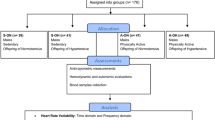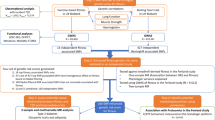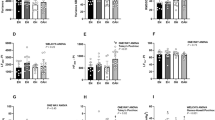Abstract
Offspring hypertensives are characterized by a hyperactive sympathetic nervous system and other early cardiovascular abnormalities that increase the risk of developing hypertension. A physically active lifestyle is associated with a lower risk of hypertension, although the mechanisms are incompletely understood and likely to be multifactorial. One aspect that has received little attention is the interaction of exercise with familial hypertension risk. The present review examines the effects of exercise on haemodynamic function in relation to the familial hypertension risk model. Paradoxically, exercise may be viewed as potent stressor to the cardiovascular system, although recent studies are beginning to show that cardiovascular adaptations, primarily mediated by changes in sympatho-vagal balance, following both acute and chronic exercise may be particularly important for individuals with familial risk of hypertension. Future studies that focus on inflammatory, metabolic, and genetic pathways may uncover further beneficial effects of exercise in relation to familial risk.
This is a preview of subscription content, access via your institution
Access options
Subscribe to this journal
Receive 12 digital issues and online access to articles
$119.00 per year
only $9.92 per issue
Buy this article
- Purchase on Springer Link
- Instant access to full article PDF
Prices may be subject to local taxes which are calculated during checkout

Similar content being viewed by others
References
Higgins MW, Keller JB, Metzner HL, Moore FE, Ostrander Jr LD . Studies of blood pressure in Tecumseh, Michigan. II. Antecedents in childhood of high blood pressure in young adults. Hypertension 1980; 2: 117–123.
Mo R, Nordrehaug JE, Omvik P, Lund-Johansen P . The Bergen Blood Pressure Study: prehypertensive changes in cardiac structure and function in offspring of hypertensive families. Blood Press 1995; 4: 16–22.
Pitzalis MV, Iacoviello M, Massari F, Guida P, Romito R, Forleo C et al. Influence of gender and family history of hypertension on autonomic control of heart rate, diastolic function and brain natriuretic peptide. J Hypertens 2001; 19: 143–148.
Manunta P, Iacoviello M, Forleo C, Messaggio E, Hamlyn JM, Lucarelli K et al. High circulating levels of endogenous ouabain in the offspring of hypertensive and normotensive individuals. J Hypertens 2005; 23: 1677–1681.
Yasmin R, Falzone R, Brown MJ . Determinants of arterial stiffness in offspring of families with essential hypertension. Am J Hypertens 2004; 17: 292–298.
Zizek B, Poredos P, Videcnik V . Endothelial dysfunction in hypertensive patients and in normotensive offspring of subjects with essential hypertension. Heart 2001; 85: 215–217.
van Hooft IM, Grobbee DE, Derkx FH, de Leeuw PW, Schalekamp MA, Hofman A . Renal hemodynamics and the renin-angiotensin-aldosterone system in normotensive subjects with hypertensive and normotensive parents. N Engl J Med 1991; 324: 1305–1311.
Michel MC, Galal O, Stoermer J, Bock KD, Brodde OE . Alpha- and beta-adrenoceptors in hypertension. II. Platelet alpha 2- and lymphocyte beta 2-adrenoceptors in children of parents with essential hypertension. A model for the pathogenesis of the genetically determined hypertension. J Cardiovasc Pharmacol 1989; 13: 432–439.
Makris TK, Stavroulakis GA, Hatzizacharias AN, Krespi PG, Margos P, Tsoukala C et al. Parental history of hypertension is associated with coagulation-fibrinolytic balance disorders. Thromb Res 2003; 111: 45–49.
Furuhashi M, Ura N, Higashiura K, Miyazaki Y, Murakami H, Hyakukoku M et al. Low adiponectin level in young normotensive men with a family history of essential hypertension. Hypertens Res 2005; 28: 141–146.
Vlasakova Z, Pelikanova T, Karasova L, Skibova J . Insulin secretion, sensitivity, and metabolic profile of young healthy offspring of hypertensive parents. Metabolism 2004; 53: 469–475.
Makris TK, Stavroulakis GA, Krespi PG, Hatzizacharias AN, Kyriaki DK, Chronakis EV et al. Elevated plasma immunoreactive leptin levels preexist in healthy offspring of patients with essential hypertension. Am Heart J 1999; 138: 922–925.
Lopes HF, Silva HB, Soares JA, Filho B, Consolim-Colombo FM, Giorgi DM et al. Lipid metabolism alterations in normotensive subjects with positive family history of hypertension. Hypertension 1997; 30: 629–631.
Andersen UB, Dige-Petersen H, Frandsen EK, Ibsen H, Volund A . Basal insulin-level oscillations in normotensive individuals with genetic predisposition to essential hypertension exhibit an irregular pattern. J Hypertens 1997; 15: 1167–1173.
Light KC, Girdler SS, Sherwood A, Bragdon EE, Brownley KA, West SG et al. High stress responsivity predicts later blood pressure only in combination with positive family history and high life stress. Hypertension 1999; 33: 1458–1464.
Fagard RH . Physical activity, fitness and blood pressure. In: Birkenhäger WH, Reid JL, Bulpitt CJ (eds). Handbook of Hypertension, vol. 20: Epidemiology of hypertension. Elsevier: Amsterdam, 2000, pp 191–211.
Wilson MF, Sung BH, Pincomb GA, Lovallo WR . Exaggerated pressure response to exercise in men at risk for systemic hypertension. Am J Cardiol 1990; 66: 731–736.
Bond Jr V, Franks BD, Tearney RJ, Wood B, Melendez MA, Johnson L et al. Exercise blood pressure response and skeletal muscle vasodilator capacity in normotensives with positive and negative family history of hypertension. J Hypertens 1994; 12: 285–290.
Matthews CE, Pate RR, Jackson KL, Ward DS, Macera CA, Kohl HW et al. Exaggerated blood pressure response to dynamic exercise and risk of future hypertension. J Clin Epidemiol 1998; 51: 29–35.
Schneiderman N, Gellman M, Peckerman A, Hurwitz B, Saab P, Llabre M . Cardiovascular reactivity as an indicator of risk for future hypertension. In: McCabe PM, Schneiderman N, Field T, Wallace AR (eds). Stress, Coping, and Cardiovascular Disease. Lawrence Erlbaum Associates: Mahwah, NJ, 2000, pp 181–202.
Holmes DS, Cappo BM . Prophylactic effect of aerobic fitness on cardiovascular arousal among individuals with a family history of hypertension. J Psychosom Res 1987; 31: 601–605.
Buckworth J, Dishman RK, Cureton KJ . Autonomic responses of women with parental hypertension: Effects of physical activity and fitness. Hypertension 1994; 24: 576–584.
Jackson EM, Dishman RK . Hemodynamic responses to stress among black women: fitness and parental hypertension. Med Sci Sports Exerc 2002; 34: 1097–1104.
Hamer M, Boutcher YN, Boutcher SH . Cardiovascular and renal responses to mental challenge in highly and moderately active males with family history of hypertension. J Hum Hypert 2002; 16: 319–326.
Buckworth J, Convertino VA, Cureton KJ, Dishman RK . Increased finger arterial blood pressure after exercise detraining in women with parental hypertension: autonomic tasks. Acta Physiol Scand 1997; 160: 29–41.
Tanzilli G, Barilla F, Pannitteri G, Greco C, Comito C, Schiariti M et al. Exercise training counteracts the abnormal release of plasma endothelin-1 in normal subjects at risk for hypertension. Ital Heart J 2003; 4: 107–112.
Georgiades A, Sherwood A, Gullette EC, Babyak MA, Hinderliter A, Waugh R et al. Effects of exercise and weight loss on mental stress-induced cardiovascular responses in individuals with high blood pressure. Hypertension 2000; 36: 171–176.
Lawler JE, Naylor SK, Wang CH . Family history of hypertension, exercise training, and reactivity to stress in rats. Int J Behav Med 1995; 2: 233–251.
Cornelissen VA, Fagard RH . Effects of endurance training on blood pressure, blood pressure-regulating mechanisms, and cardiovascular risk factors. Hypertension 2005; 46: 667–675.
Rice T, An P, Gagnon J, Leon AS, Skinner JS, Wilmore JH et al. Heritability of HR and BP response to exercise training in the HERITAGE Family Study. Med Sci Sports Exerc 2002; 34: 972–979.
An P, Perusse L, Rankinen T, Borecki IB, Gagnon J, Leon AS et al. Familial aggregation of exercise heart rate and blood pressure in response to 20 weeks of endurance training: the HERITAGE Family Study. Int J Sports Med 2003; 24: 57–62.
Rivera MA, Echegaray M, Rankinen T, Perusse L, Rice T, Gagnon J et al. TGF-beta(1) gene-race interactions for resting and exercise blood pressure in the HERITAGE Family Study. J Appl Physiol 2001; 91: 1808–1813.
Rankinen T, Gagnon J, Perusse L, Chagnon YC, Rice T, Leon AS et al. AGT M235 T and ACE ID polymorphisms and exercise blood pressure in the HERITAGE Family Study. Am J Physiol Heart Circ Physiol 2000; 279: H368–H374.
Montgomery HE, Clarkson P, Dollery CM, Prasad K, Losi MA, Hemingway H et al. Association of angiotensin-converting enzyme gene I/D polymorphism with change in left ventricular mass in response to physical training. Circulation 1997; 96: 741–747.
Mack GW, Thompson CA, Doerr DF, Nadel ER, Convertino VA . Diminished baroreflex control of forearm vascular resistance following training. Med Sci Sports Exerc 1991; 23: 1367–1374.
McCubbin JA, Surwit RS, Williams Jr RB . Opioid dysfunction and risk for hypertension: naloxone and blood pressure responses during different types of stress. Psychosom Med 1988; 50: 8–14.
McCubbin JA, Cheung R, Montgomery TB, Bulbulian R, Wilson JF . Aerobic fitness and opioidergic inhibition of cardiovascular stress reactivity. Psychophysiology 1992; 29: 687–697.
Spina RJ, Turner MJ, Ehsani AA . Beta-adrenergic-mediated improvement in left ventricular function by exercise training in older men. Am J Physiol 1998; 274: H397–H404.
Spina RJ, Bourey RE, Ogawa T, Ehsani AA . Effects of exercise training on alpha-adrenergic mediated pressor responses and baroreflex function in older subjects. J Gerontol 1994; 49: B277–B281.
Martin III WH, Spina RJ, Korte E, Ogawa T . Effects of chronic and acute exercise on cardiovascular beta-adrenergic responses. J Appl Physiol 1991; 71: 1523–1528.
Lenard Z, Studinger P, Mersich B, Pavlik G, Kollai M . Cardiovagal autonomic function in sedentary and trained offspring of hypertensive parents. J Physiol 2005; 565: 1031–1038.
Liao D, Arnett DK, Tyroler HA, Riley WA, Chambless LE, Szklo M et al. Arterial stiffness and the development of hypertension. The ARIC study Hypertension 1999; 34: 201–206.
Endre T, Mattiasson I, Hulthen UL, Lindgarde F, Berglund G . Insulin resistance is coupled to low physical fitness in normotensive men with a family history of hypertension. J Hypertens 1994; 12: 81–88.
Pescatello LS, Franklin BA, Fagard R, Farquhar WB, Kelley GA, Ray CA . American College of Sports Medicine position stand. Exercise and hypertension. Med Sci Sports Exerc 2004; 36: 533–553.
MacDonald JR . Potential causes, mechanisms, and implications of post exercise hypotension. J Hum Hypertens 2002; 16: 225–236.
Halliwill JR . Mechanisms and clinical implications of post-exercise hypotension in humans. Exerc Sport Sci Rev 2001; 29: 65–70.
Hamer M, Taylor A, Steptoe A . The effect of acute aerobic exercise on stress related blood pressure responses: a systematic review and meta-analysis. Biol Psychol 2006; 71: 183–190.
Hamer M, Jones J, Boutcher SH . Acute exercise reduces vascular reactivity to mental challenge in offspring of hypertensive families. J Hypertens 2006; 24: 315–320.
Halliwill JR, Lawler LA, Eickhoff TJ, Dietz NM, Nauss LA, Joyner MJ . Forearm sympathetic withdrawal and vasodilatation during mental stress in humans. J Physiol 1997; 504: 211–220.
Peronnet F, Massicotte D, Paquet JE, Brisson G, de Champlain J . Blood pressure and plasma catecholamine responses to various challenges during exercise recovery in man. Eur J Appl Physiol 1989; 58: 551–555.
Brownley KA, Hinderliter AL, West SG, Girdler SS, Sherwood A, Light KC . Sympathoadrenergic mechanisms in reduced hemodynamic stress responses after exercise. Med Sci Sports Exerc 2003; 35: 978–986.
Blaes N, Boissel JP . Growth stimulating effect of catecholamines on rat aortic smooth muscle cells in culture. J Cell Physiol 1983; 116: 167–172.
Macnair AL . Is inactivity the origin of essential hypertension: should we all be runners? Nephrol Dial Transplant 2000; 15: 1751–1754.
Julius S . Corcoran Lecture. Sympathetic hyperactivity and coronary risk in hypertension. Hypertension 1993; 21: 886–893.
O'Connor DT, Kailasam MT, Kennedy BP, Ziegler MG, Yanaihara N, Parmer RJ . Early decline in the catecholamine release-inhibitory peptide catestatin in humans at genetic risk of hypertension. J Hypertens 2002; 20: 1335–1345.
Bauer N, Muller-Ehmsen J, Kramer U, Hambarchian N, Zobel C, Schwinger RH et al. Ouabain-like compound changes rapidly on physical exercise in humans and dogs: effects of beta-blockade and angiotensin-converting enzyme inhibition. Hypertension 2005; 45: 1024–1028.
El-Sayed MS, Ali N, El-Sayed Ali Z . Aggregation and activation of blood platelets in exercise and training. Sports Med 2005; 35: 11–22.
Grundy SM . Inflammation, hypertension, and the metabolic syndrome. JAMA 2003; 290: 3000–3002.
Petersen AM, Pedersen BK . The anti-inflammatory effect of exercise. J Appl Physiol 2005; 98: 1154–1162.
Abramson JL, Vaccarino V . Relationship between physical activity and inflammation among apparently healthy middle-aged and older US adults. Arch Intern Med 2002; 162: 1286–1292.
Tomaszewski M, Charchar FJ, Crawford L, Zukowska-Sczechowska E, Grzeszczak W, Sattar N et al. Serum C-reactive protein and lipids in ultra-Marathon runners. Am J Cardiol 2004; 94: 125–126.
Mattusch F, Dufaux B, Heine O, Mertens I, Rost R . Reduction of the plasma concentration of C-reactive protein following nine months of endurance training. Int J Sports Med 2000; 21: 21–24.
Tsukui S, Kanda T, Nara M, Nishino M, Kondo T, Kobayashi I . Moderate-intensity regular exercise decreases serum tumor necrosis factor-alpha and HbA1c levels in healthy women. Int J Obes Rel Met Dis 2000; 24: 1207–1211.
Allemann Y, Hutter D, Aeschbacher BC, Fuhrer J, Delacretaz E, Weidmann P . Increased central body fat deposition precedes a significant rise in resting blood pressure in male offspring of essential hypertensive parents: a 5 year follow-up study. J Hypertens 2001; 19: 2143–2148.
Acknowledgements
MH is supported by a grant from the British Heart Foundation, UK.
Author information
Authors and Affiliations
Corresponding author
Rights and permissions
About this article
Cite this article
Hamer, M. The effects of exercise on haemodynamic function in relation to the familial hypertension risk model. J Hum Hypertens 20, 313–319 (2006). https://doi.org/10.1038/sj.jhh.1001999
Received:
Revised:
Accepted:
Published:
Issue Date:
DOI: https://doi.org/10.1038/sj.jhh.1001999
Keywords
This article is cited by
-
An ethnic-sensitive approach for the promotion of a healthy lifestyle: is it warranted?
Journal of Human Hypertension (2008)



